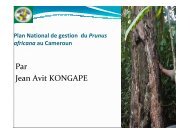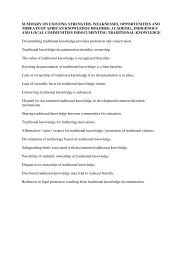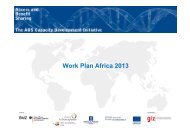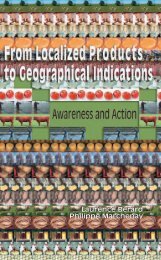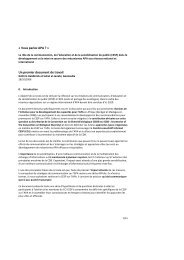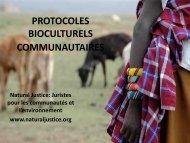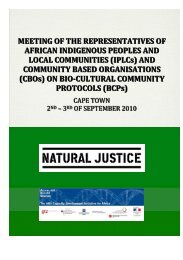The History of Farmers' Rights - Fridtjof Nansens Institutt
The History of Farmers' Rights - Fridtjof Nansens Institutt
The History of Farmers' Rights - Fridtjof Nansens Institutt
Create successful ePaper yourself
Turn your PDF publications into a flip-book with our unique Google optimized e-Paper software.
14 Regine Andersen<br />
for present and future generations <strong>of</strong> farmers, for the purpose <strong>of</strong><br />
ensuring full benefits to farmers, and supporting the continuation<br />
<strong>of</strong> their contributions, as well as the attainment <strong>of</strong> the overall<br />
purposes <strong>of</strong> the International Undertaking) in order to:<br />
a) ensure that the need for conservation is globally recognized<br />
and that sufficient funds for these purposes will be available;<br />
b) assist farmers and farming communities, in all regions <strong>of</strong> the<br />
world, but especially in the areas <strong>of</strong> origin/diversity <strong>of</strong> plant<br />
genetic resources, in the protection and conservation <strong>of</strong> their<br />
plant genetic resources, and <strong>of</strong> the natural biosphere;<br />
c) allow farmers, their communities, and countries in all regions,<br />
to participate fully in the benefits derived, at present<br />
and in the future, from the improved use <strong>of</strong> plant genetic resources,<br />
through plant breeding and other scientific methods.<br />
Though this resolution was a milestone, it was not legally binding, nor<br />
were the ways in which it was to be implemented delineated. Furthermore,<br />
the ‘definition’ did not actually define the concept. It stated where<br />
the concept had arisen and the purpose <strong>of</strong> farmers’ rights. What they were<br />
rights to, who the rights holders were, and how the rights were to be<br />
maintained – these issues were not clarified. Thus we may say that the<br />
resolution marked an important beginning, but the actual realization <strong>of</strong><br />
farmers’ rights would require a lot <strong>of</strong> further conceptualization and<br />
operationalization.<br />
FAO, 1991: Report <strong>of</strong> the Conference <strong>of</strong> FAO, Twenty-sixth Session,<br />
Rome, 9–27 November 1991, C 1991/REP.<br />
In 1991 a new annex to the International Undertaking was adopted (C<br />
1991/REP, Conference Resolution 3/91). This time, the FAO Conference<br />
stated that the concept <strong>of</strong> genetic resources being the heritage <strong>of</strong><br />
mankind, as applied in the Undertaking, was subject to the sovereignty <strong>of</strong><br />
the States (ibid, paragraph a). 13 Against this background it also stated that<br />
the conditions for access to plant genetic resources required further<br />
clarification (ibid, paragraph d). This was a highly controversial issue,<br />
which caused heated debate. To balance between proponents and opponents<br />
and reach to a consensus decision, the Conference again adopted<br />
provisions on farmers’ rights. Building on the negotiations in 1987 and<br />
the 1989 resolutions, the Conference decided (ibid, paragraph 3):<br />
13 This principle <strong>of</strong> international law was confirmed at the UN Conference on the<br />
Human Environment, 1972. In the Declaration <strong>of</strong> the United Nations Conference<br />
on the Human Environment (available at www.unep.org/Documents.multiling<br />
ual/Default.aspDocumentID=97&ArtilcleID=1503) reference is made to the UN<br />
Charter, and it is stated that states have the sovereign rights to exploit their own<br />
resources pursuant to their own environmental policies (Principle 21). <strong>The</strong> Commission<br />
on Genetic Resources reaffirmed these rights already at its first meeting<br />
in 1985, in an effort to attract further countries to adhere to the International<br />
Undertaking: ‘With regard to Article 1 and 5 <strong>of</strong> the Undertaking, the commission<br />
agreed that the sovereignty <strong>of</strong> governments over their plant genetic resources<br />
should be respected and that reciprocity in the exchange process was included in<br />
the substance <strong>of</strong> the Undertaking’ (CPGR/85/REP, Paragraph 9).





